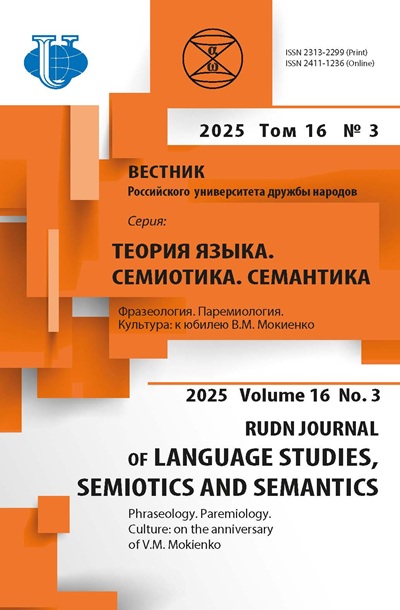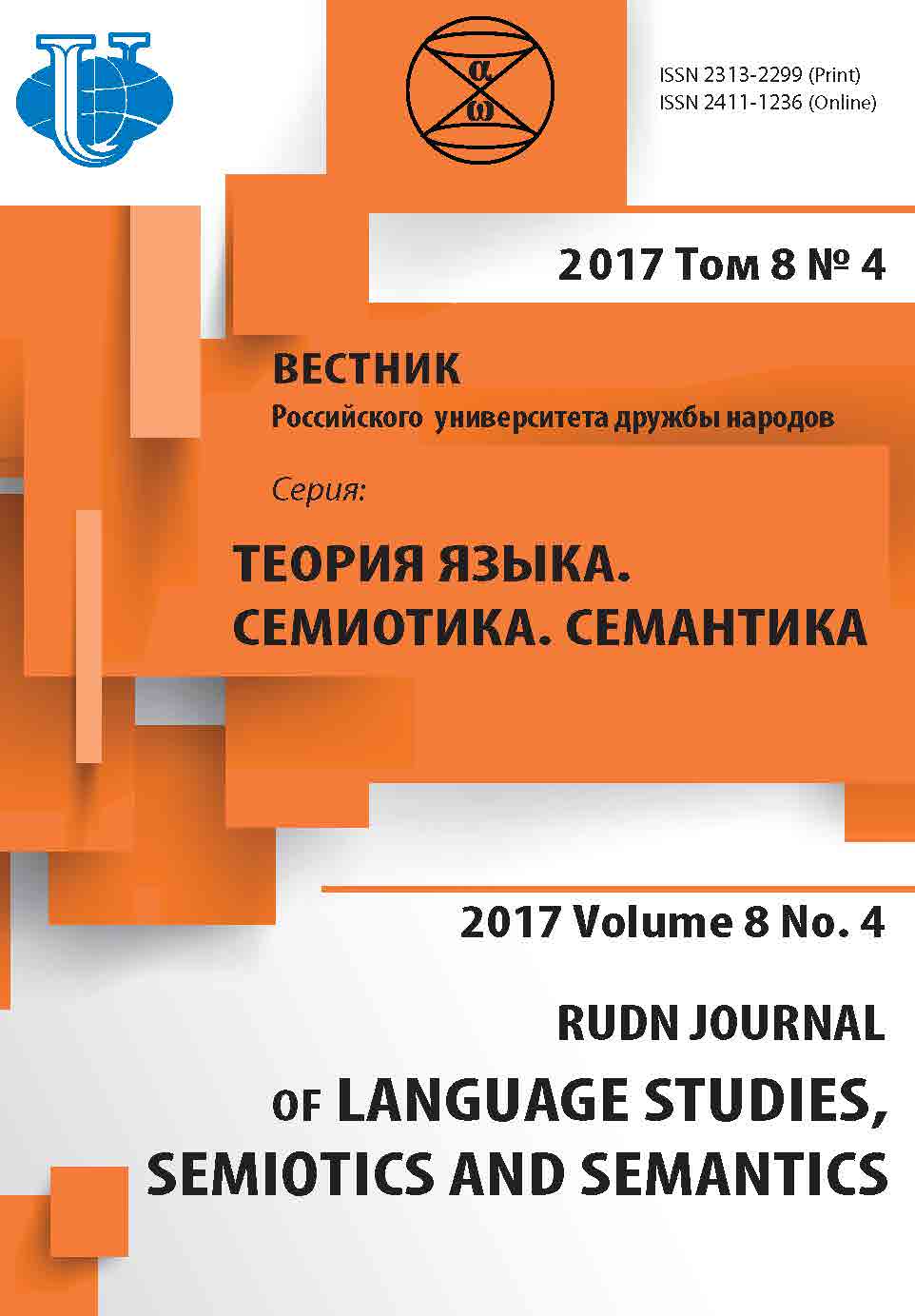ПЕРЕВОД ИДИОМ С КОМПОНЕНТОМ-НАЗВАНИЕМ ЦВЕТА (на материале английского, арабского и испанского языков)
- Авторы: Фитьян Рима -1, Аскутия Майте -1
-
Учреждения:
- Российский университет дружбы народов
- Выпуск: Том 8, № 4 (2017)
- Страницы: 930-938
- Раздел: СТАТЬИ
- URL: https://journals.rudn.ru/semiotics-semantics/article/view/17971
- DOI: https://doi.org/10.22363/2313-2299-2017-8-4-930-938
- ID: 17971
Цитировать
Полный текст
Аннотация
Человеческое общение является сферой актуальных научных исследований лингвистов, антропологов, психологов и философов. История, культура, мировоззрение народа взаимосвязаны и находят свое отражение во фразеологии, единицы которой являются своеобразными декодерами традиций, социальных убеждений, традиций и стандартов общества. Идиомы, как составной элемент общения с носителями языка, передают основные идеи, принципы и ценности отдельно взятой культуры и народа. Изучение идиом является хорошим ресурсом для умножения знаний любого языка.
Ключевые слова
Об авторах
- Фитьян Рима
Российский университет дружбы народов
Автор, ответственный за переписку.
Email: r.m.fityan@gmail.com
Фитьян Рима, аспирант кафедры общего и русского языознания филологического факультета РУДН; научные интересы: перевод, межкультурная коммуникация; е
ул. Миклухо-Маклая, 6, Москва, Россия, 117198- Аскутия Майте
Российский университет дружбы народов
Email: maiteazcutia@gmail.com
Аскутия Майте, выпускница Университета Страны Басков (специальность - «Перевод», специализация «английский и русский языки»; научные интересы: теория перевода, межкультурная коммуникация
ул. Миклухо-Маклая, 6, Москва, Россия, 117198Список литературы
- Akbari, M. (2013). Strategies for Translating Idioms. URL: https://fr.scribd.com/doc/219484811/ Strategies-for-Translating-Idioms (accessed: 08.08.2016).
- Al-Adaileh, B. The Connotations of Arabic Colour Terms. URL: http://www.phil.muni.cz/ linguistica/art/al-adaileh/ada-001.pdf (accessed: 07.01.2017).
- Fityan Reema, Azcutia Maite. RUDN Journal of Language Studies, Semiotics and Semantics, 2017, 8 (4), 930-938 SCIENCE 21.0 937
- Bell, R. (1991). Translation and translating. London: Longman.
- Hester, S. & Eglin, P. (1997). Culture in Action: Studies in Membership Categorization.
- Hongwei, C. (1999). Cultural difference and translation. Translations' Journal, 44, 121-132.
- House, J. (2009). Translation. Oxford: Oxford Un iversity Press.
- Katan, D. (1999). Translating Cultures: An Introduction for Translators, Interpreters and Mediators. Manchester: St Jerome.
- Katan, D. (2009). Translation as Intercultural Communication. In J. Munday (Ed.), The Routledge companion to translation studies (pp. 74-92). Abingdon: Routledge.
- Lambert, J. (2000). Cultural Studies, The Study of Cultures and The Question of Language : F acing / Excluding in New Millennium. In D. Delabastita , L. D'hulst, & R. Meylaerts (2006), Functional approach to culture and translation (pp. 163-172). Amsterdam: John Benj amins Lar sen, M. (1984). Leppihalme, R. (1997). Culture bumps. Clevedon: Multilingul Matters.
- Munday, J. (2001). Introducting translation studies. Routledge 270 Madison Ave, New York, NY 10016.
- Newmark, P. (1988). A textbook of translation. Hamel Hempstead: Prentice Hall.
- Nida, E. & Taber, C. (1969). The theory and practice of translation. Leiden: E.J. Brill.
- Paluszkiewicz-Misiaczek, M. (2005). Strategies and methods in dealing with culture specific expressions on the basis of Polish-English translations of certain administrative and institutiona l terms. Th eory and Practice in English Studies, 3, 243-248.
- Reddick, R. (1992). English expository discourse. Language in Context: Essays for Robert E. Longacre, Shin Ja.J., Hwang and W.R. Merrifield (Eds), Arlington: The Summer Ins titute of Linguistics and The University of Texas at Arlington.
- Salehi, M. (2012). Reflections on Culture, Language and Translation. URL: http://www.ipedr.com/ vol33/017-ICLMC2012-L00062.pdf (access ed: 05.01.2017).
- Vasiljevic, Z. (2015). Effects of Etymology and Pictorial Support on the Retention and R ecall of L2 Idioms. Electronic Journal of Foreign Language Teaching, 12(1), 35-55. URL: http://e-flt.nus.edu.sg/v12n 12015/vasiljevic.pdf (accesse d: 09.09.2016).
- Vega-Moreno, R.E. Representing and processing idioms. URL: http://www.phon.ucl.ac.uk/ publications/ WPL/01papers/vega.pdf (accessed: 05.01.2017).
- Venuti, L. (1995). The Translator’s Invisibility: A history of translation. London and New York: Routledge.
- Xing, J.Z. (2008). Semantics and Pragmatics of Colour Terms in Chinese. Washington : Western Was hington Un iversity.
- Yagiz, O. & Izadpanah, S. Language, Culture, Idioms, and Their Re lationship with the Foreign Language. Journal of Language Teaching and Research, Vol. 4(5), 953-957 URL: http://www.academypublicatio n.com/issues/past/jltr/vol04/05/07. pdf (accessed: 09.09.2016)
Дополнительные файлы












